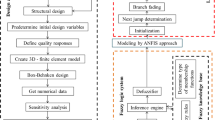Abstract
This paper proposes an efficient hybrid approach for solving multi-objective optimization design of a compliant mechanism. The approach is developed by integrating desirability function approach, fuzzy logic system, adaptive neuro-fuzzy inference system, and Lightning attachment procedure optimization. Box–Behnken design is used to form a numerically experimental matrix. First, a refinement of design variables is conducted through analysis of variance and Taguchi approach in terms of considerably eliminating space of design variables and computation efforts. Next, desirability of two objective functions is computed and transferred into the fuzzy logic system. The output of fuzzy logic system is regarded as single combined objective function. Subsequently, a modeling for fuzzy output is developed via adaptive neuro-fuzzy inference system. Then, LAPO algorithm is adopted for solving the optimization problem. By investigating three different numerical examples, performance of the proposed approach is validated. Numerical results revealed that the proposed approach has a computational accuracy better than that of Taguchi-based fuzzy logic reasoning. Finally, case study 1 is chosen as an optimal solution for the mechanism. Furthermore, the effectiveness of proposed approach is greater than that of the Jaya algorithm and TLBO algorithm through Wilcoxon signed rank test and Friedman test. The proposed approach can be used for related engineering fields.












Similar content being viewed by others
References
Ling M, Chen S, Li Q, Tian G (2018) Dynamic stiffness matrix for free vibration analysis of flexure hinges based on non-uniform Timoshenko beam. J Sound Vib 437:40–52. https://doi.org/10.1016/j.jsv.2018.09.013
Zhang J, Guo HW, Zhang ZN (2019) Design of flexure revolute joint based on double compliant curved beam. Proc Inst Mech Eng Part C J Mech Eng Sci 233:4521–4530. https://doi.org/10.1177/0954406219833085
Dao T-P, Huang S-C (2017) Design and analysis of a compliant micro-positioning platform with embedded strain gauges and viscoelastic damper. Microsyst Technol. https://doi.org/10.1007/s00542-016-3048-3
Ling M, Cao J, Jiang Z, Li Q (2018) Development of a multistage compliant mechanism with new boundary constraint. Rev Sci Instrum. https://doi.org/10.1063/1.5007890
Chen S, Ling M, Zhang X (2018) Design and experiment of a millimeter-range and high-frequency compliant mechanism with two output ports. Mech Mach Theory 126:201–209. https://doi.org/10.1016/j.mechmachtheory.2018.04.003
Teo TJ, Chen IM, Yang G, Lin W (2010) A generic approximation model for analyzing large nonlinear deflection of beam-based flexure joints. Precis Eng 34:607–618. https://doi.org/10.1016/j.precisioneng.2010.03.003
Wang N, Zhang Z, Zhang X, Cui C (2018) Optimization of a 2-DOF micro-positioning stage using corrugated flexure units. Mech Mach Theory 121:683–696. https://doi.org/10.1016/j.mechmachtheory.2017.11.021
Liu M, Zhang X, Fatikow S (2016) Design and analysis of a high-accuracy flexure hinge. Rev Sci Instrum. https://doi.org/10.1063/1.4948924
Xu Q, Li Y (2011) Analytical modeling, optimization and testing of a compound bridge-type compliant displacement amplifier. Mech Mach Theory 46:183–200. https://doi.org/10.1016/j.mechmachtheory.2010.09.007
Dao TP, Huang SC (2017) Design and multi-objective optimization for a broad self-amplified 2-DOF monolithic mechanism. Sadhana Acad Proc Eng Sci 42:1527–1542. https://doi.org/10.1007/s12046-017-0714-9
Choi KB, Han CS (2007) Optimal design of a compliant mechanism with circular notch flexure hinges. Proc Inst Mech Eng Part C J Mech Eng Sci 221:385–392. https://doi.org/10.1243/0954406JMES312
Costa NR, Lourenço J, Pereira ZL (2011) Desirability function approach: a review and performance evaluation in adverse conditions. Chemom Intell Lab Syst 107:234–244. https://doi.org/10.1016/j.chemolab.2011.04.004
Huang SC, Dao TP (2016) Multi-objective optimal design of a 2-DOF flexure-based mechanism using hybrid approach of Grey-Taguchi coupled response surface methodology and entropy measurement. Arab J Sci Eng 41:5215–5231. https://doi.org/10.1007/s13369-016-2242-z
Dao T-P (2016) Multiresponse optimization of a compliant guiding mechanism using hybrid Taguchi-Grey based fuzzy logic approach. Math Probl Eng. https://doi.org/10.1155/2016/5386893
Arasu MV, Arokiyaraj S, Viayaraghavan P et al (2019) One step green synthesis of larvicidal, and azo dye degrading antibacterial nanoparticles by response surface methodology. J Photochem Photobiol B Biol 190:154–162. https://doi.org/10.1016/j.jphotobiol.2018.11.020
Jiang P, Wang C, Zhou Q et al (2016) Optimization of laser welding process parameters of stainless steel 316L using FEM, Kriging and NSGA-II. Adv Eng Softw 99:147–160. https://doi.org/10.1016/j.advengsoft.2016.06.006
Wang B, Moayedi H, Nguyen H et al (2019) Feasibility of a novel predictive technique based on artificial neural network optimized with particle swarm optimization estimating pullout bearing capacity of helical piles. Eng Comput. https://doi.org/10.1007/s00366-019-00764-7
Koopialipoor M, Fahimifar A, Ghaleini EN et al (2019) Development of a new hybrid ANN for solving a geotechnical problem related to tunnel boring machine performance. Eng Comput. https://doi.org/10.1007/s00366-019-00701-8
Macura L, Voznak M (2017) Multi-criteria analysis and prediction of network incidents using monitoring system. J Adv Eng Comput 1:29. https://doi.org/10.25073/jaec.201711.47
Moayedi H, Raftari M, Sharifi A et al (2019) Optimization of ANFIS with GA and PSO estimating α ratio in driven piles. Eng Comput. https://doi.org/10.1007/s00366-018-00694-w
Cuevas E, Díaz P, Avalos O et al (2018) Nonlinear system identification based on ANFIS-Hammerstein model using Gravitational search algorithm. Appl Intell 48:182–203. https://doi.org/10.1007/s10489-017-0969-1
Keshtiara M, Golabi S, Tarkesh Esfahani R (2019) Multi-objective optimization of stainless steel 304 tube laser forming process using GA. Eng Comput. https://doi.org/10.1007/s00366-019-00814-0
Le CN, Le HG, Dao T et al (2019) Efficient hybrid method of FEA-based RSM and PSO algorithm for multi-objective optimization design for a compliant rotary joint for upper limb assistive device. https://www.springer.com/engineering/electronics/j. Accessed 30 Oct 2019
Dao T-P, Huang S-C, Le Chau N (2017) Robust parameter design for a compliant microgripper based on hybrid Taguchi-differential evolution algorithm. Microsyst Technol. https://doi.org/10.1007/s00542-017-3534-2
Dao T-P, Huang S-C, Thang PT (2017) Hybrid Taguchi-cuckoo search algorithm for optimization of a compliant focus positioning platform. Appl Soft Comput J. https://doi.org/10.1016/j.asoc.2017.04.038
Cuevas E, Gálvez J, Avalos O (2017) Parameter estimation for chaotic fractional systems by using the locust search algorithm. Comput y Sist 21:369–380. https://doi.org/10.13053/CyS-21-2-2741
Cuevas E, Cienfuegos M (2014) A new algorithm inspired in the behavior of the social-spider for constrained optimization. Expert Syst Appl 41:412–425. https://doi.org/10.1016/j.eswa.2013.07.067
Cuevas E, Cienfuegos M, Zaldívar D, Pérez-Cisneros M (2013) A swarm optimization algorithm inspired in the behavior of the social-spider. Expert Syst Appl 40:6374–6384. https://doi.org/10.1016/j.eswa.2013.05.041
Oliva D, Cuevas E, Pajares G (2014) Parameter identification of solar cells using artificial bee colony optimization. Energy 72:93–102. https://doi.org/10.1016/j.energy.2014.05.011
Cuevas E, Sención-Echauri F, Zaldivar D, Pérez-Cisneros M (2012) Multi-circle detection on images using artificial bee colony (ABC) optimization. Soft Comput 16:281–296. https://doi.org/10.1007/s00500-011-0741-0
Senkerik R, Zelinka I, Pluhacek M (2017) Chaos-based optimization—a review. J Adv Eng Comput 1:68. https://doi.org/10.25073/jaec.201711.51
Zatloukal F, Znoj J (2017) Malware detection based on multiple pe headers identification and optimization for specific types of files. J Adv Eng Comput 1:153. https://doi.org/10.25073/jaec.201712.64
Chernogorov I, Polyakh V, Yarakhmedov O (2017) Search optimization opportunities of modified self-organizing migrating algorithm in multi-extremal tasks environment. J Adv Eng Comput 1:144. https://doi.org/10.25073/jaec.201712.60
Dinh-Cong D, Pham-Duy S, Nguyen-Thoi T (2018) Damage detection of 2D frame structures using incomplete measurements by optimization procedure and model reduction. J Adv Eng Comput 2:164. https://doi.org/10.25073/jaec.201823.203
Venkata Rao R (2016) Review of applications of tlbo algorithm and a tutorial for beginners to solve the unconstrained and constrained optimization problems. Decis Sci Lett 5:1–30. https://doi.org/10.5267/j.dsl.2015.9.003
Rao RV, Keesari HS, Oclon P, Taler J (2019) An adaptive multi-team perturbation-guiding Jaya algorithm for optimization and its applications. Eng Comput. https://doi.org/10.1007/s00366-019-00706-3
Nematollahi AF, Rahiminejad A, Vahidi B (2017) A novel physical based meta-heuristic optimization method known as Lightning Attachment Procedure Optimization. Appl Soft Comput J 59:596–621. https://doi.org/10.1016/j.asoc.2017.06.033
Derringer G, Suich R (1980) Simultaneous optimization of several response variables. J Qual Technol 12:214–219. https://doi.org/10.1080/00224065.1980.11980968
Díaz-Cortés MA, Cuevas E, Gálvez J, Camarena O (2017) A new metaheuristic optimization methodology based on fuzzy logic. Appl Soft Comput J 61:549–569. https://doi.org/10.1016/j.asoc.2017.08.038
Zhou J, Li C, Arslan CA et al (2019) Performance evaluation of hybrid FFA-ANFIS and GA-ANFIS models to predict particle size distribution of a muck-pile after blasting. Eng Comput. https://doi.org/10.1007/s00366-019-00822-0
Foroughi Nematollahi A, Rahiminejad A, Vahidi B (2019) A novel multi-objective optimization algorithm based on Lightning Attachment Procedure Optimization algorithm. Appl Soft Comput J 75:404–427. https://doi.org/10.1016/j.asoc.2018.11.032
Zheng T, Luo W (2019) An enhanced lightning attachment procedure optimization with quasi-opposition-based learning and dimensional search strategies. Comput Intell Neurosci 2019:1–24. https://doi.org/10.1155/2019/1589303
Rao RV, Saroj A (2019) An elitism-based self-adaptive multi-population Jaya algorithm and its applications. Soft Comput 23:4383–4406. https://doi.org/10.1007/s00500-018-3095-z
Rao RV, Savsani VJ, Vakharia DP (2012) Teaching-learning-based optimization: an optimization method for continuous non-linear large scale problems. Inf Sci (Ny) 183:1–15. https://doi.org/10.1016/j.ins.2011.08.006
García S, Molina D, Lozano M, Herrera F (2009) A study on the use of non-parametric tests for analyzing the evolutionary algorithms’ behaviour: a case study on the CEC’2005 Special Session on Real Parameter Optimization. J Heuristics 15:617–644. https://doi.org/10.1007/s10732-008-9080-4
Acknowledgements
This research is funded by Vietnam National Foundation for Science and Technology Development (NAFOSTED) under Grant number 107.01-2019.14.
Author information
Authors and Affiliations
Corresponding author
Ethics declarations
Conflict of interest
The authors declare that they have no conflict of interest.
Additional information
Publisher's Note
Springer Nature remains neutral with regard to jurisdictional claims in published maps and institutional affiliations.
Rights and permissions
About this article
Cite this article
Tran, N.T., Le Chau, N. & Dao, TP. An effective hybrid approach of desirability, fuzzy logic, ANFIS and LAPO algorithm for optimizing compliant mechanism. Engineering with Computers 37, 2591–2621 (2021). https://doi.org/10.1007/s00366-020-00963-7
Received:
Accepted:
Published:
Issue Date:
DOI: https://doi.org/10.1007/s00366-020-00963-7




